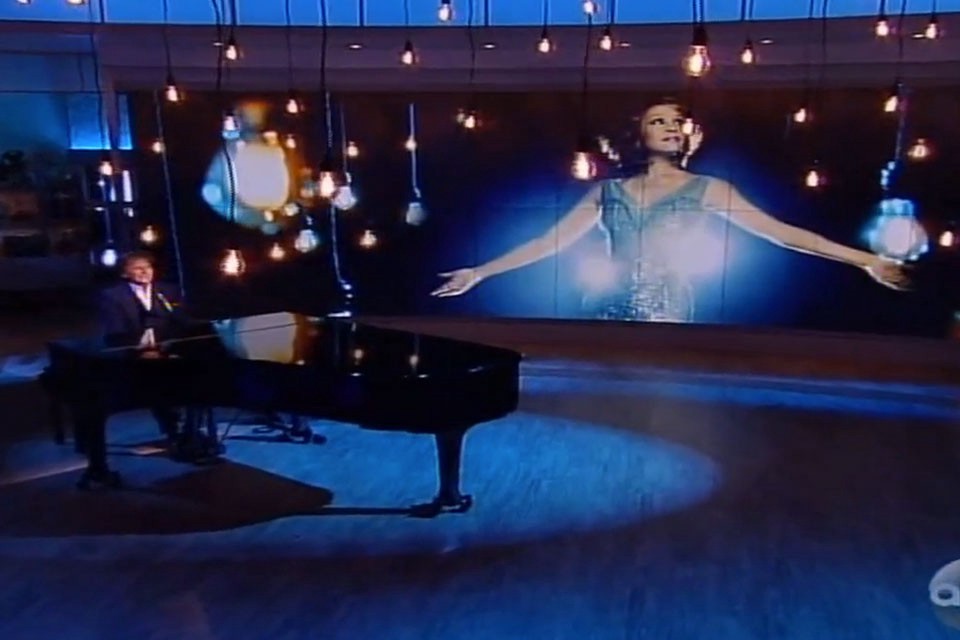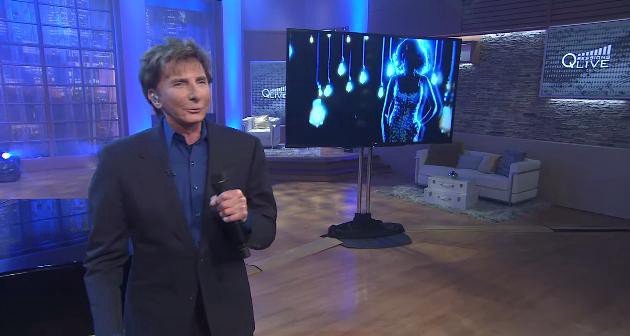How to Sing With Dead People: Barry Manilow’s My Dream Duets
by Rahawa Haile


Something strange happened when I searched for Whitney Houston on Spotify last month. Instead of an image depicting a goddess who made origami swans of the word “actually” in her sleep, who would be my baby tonight and every night until the end of recorded time, a turtle-like figure hunched in the corner of the screen, its neck craned skyward below the words “latest release.” Accompanying this distinct Not-The-Face-Of-My-Black-Empress were six more words: “I Believe in You and Me.”
My heart sank. “What treachery is this?” tingled strategically distributed black outrage sensors, each in the shape of Phylicia Rashād. Dare I click? I stepped quietly away from my work desk and into the Potential Rage room on my office floor. I took a deep breath.
There it was: Barry Manilow’s “I Believe in You and Me.” Was this a cover? No. It was a “dream duet” from his new album My Dream Duets, or How to Sing With Dead People. These were formerly songs of, by today’s standards, questionable audio fidelity, whose vocal tracks Manilow’s engineers had isolated, then zoomed in and enhanced. This allowed Manilow to then rearrange and retouch beloved tunes otherwise foreign to multitrack recording.
Contrary to the assertions of some, one can’t sing a live duet with a decidedly dead performer. At best you can sing a simultaneously alive-and-dead duet, hereby known as the Schrödinger’s Cat Collabo.
Steeling myself, I seized the opportunity to watch the fruits of his labor during a live performance of the album on QVC. “We put together some videos for these songs so you can see them as well as hear them,” crooned Manilow. A grand piano and television screen took center stage, but over the course of an hour I cringed less and less as my skepticism dissipated. Intent mattered here. These weren’t songs I’d ever want to listen to again in their current iterations, but the earnestness with which Manilow spoke of his love for the originals moved me. I was touched.
The more I heard him discuss the project, the more it became clear how ecstatic it had made him, how proud he was of the repeatedly-thanked audio engineers. These really were his dream duets, and he was humbled by the feat. When asked about harmonies, Manilow exclaimed, “My goal was to have the audience feel how talented these people were. I tried not to get in their way.”
To be clear, Manilow is a man who loves harmony. Really loves it. He wrote a musical called Harmony. So what if he penned a spit valve of a song titled “What a Wonderful Life,” meant to be layered atop Louis Armstrong’s “What a Wonderful World”? All Manilow wants is to talk about letting the voices of dead singers breathe as though he were an aural sommelier for Hades. Which is all well and good, except when it comes to Whitney.
Houston’s “I Believe in You and Me” is itself a cover of a Four Tops’ single that makes Momofuku’s cereal milk ice cream look tart. If some hairless, heat-resistant incarnation of you wished to know how it felt to swim in a pool of warmed caramel, it could listen to Levi Stubbs’s rendition and towel off invigorated.
But in 1996, Houston covered it for the Penny Marshall holiday film The Preacher’s Wife, itself a remake of 1947’s The Bishop’s Wife.
How can I put this? It doesn’t matter whether you’ve seen the film; before Beyoncé and Jay Z, Whitney Houston singing “I Believe in You and Me” to Denzel Washington in 1996 was the definition of black love and black superstardom. Washington played an angel who adored pizza, saving marriages, and smiling at the woman whose 1993 Billboard performance of “I Have Nothing” temporarily extinguished life on earth. When Lionel Richie prods Houston into singing at a jazz club in the film, asserting that she carries the secret to “what lovin’ really sounds like” in her voice, Washington gently responds: “I’d like to know what love really sounds like.”
Penny Marshall knew. She spent 10 seconds zooming in on Washington’s enraptured face as he heard it. I would hear it again in the coming years. The sheer power of her, the beauty; the firing shot of a long goodbye.
Across pop culture, the mid-90s felt like a time when black stars were everywhere, demolishing previously held records and earning quantifiable recognition. That last part has changed. Then, you could find us towering on the charts (sorry Bey), across critically acclaimed black sitcoms, in a variety of nonreductive black films. It’s gotten better in recent years, particularly in television, but nothing like it was then.
This is the context in which I and others (roughly 6 million copies of The Preacher’s Wife soundtrack have been sold worldwide) experienced “I Believe in You and Me,” a time of infinite possibility and two Chicago Bulls three-peats. To hear it stripped of this in My Dream Duets reduces a massive cultural signifier to the happenstance physics of timbre. The “why” and “whom for” vanish. It’s how we get Annie Lennox claiming “Strange Fruit” as a song of universal struggle.
In this way, Manilow’s albums is a tribute to content over substance. In “I Believe in You and Me” he alters the words “my love” in the opening verse to “my friend,” making it the neutered complement to Sam Smith’s infuriating, gender-neutral cover of Houston’s “How Will I Know” from earlier this year.
My Dream Duets is also far from the first dead duet album. A 1965 Billboard review describes Father & Son by Hank Williams Sr. & Hank Williams Jr., the earliest dead duet album I could find, as such:
This deluxe LP has been referred to as a ‘modern-day electronics miracle,’ and indeed it is. Hank Jr. bears a striking vocal resemblance to his dad. They are heard here dueling on memorable Williams hits. A remarkably done dual-tracking process gives the effect of a new recording of both voices. The result is [a] worthy collector’s item.
Fifty years later, tribute is not without its issues. The video of Manilow performing with Whitney Houston uses a random, backlit black woman in place of the star. While chances are this was a matter of failing to obtain rights to Houston’s likeness more than a microagression, it is also a nod to the ease with which one can erase an icon even in reanimation.
The slight appears to have had little effect on Manilow’s fans. According to QVC host Carolyn Gracie, 6,000 units of My Dream Duets were ordered in the first 15 minutes of the show, over 10,000 at the halfway mark, and by the end of the hour more than 21,000 records had been sold. The album would go on to debut on the Billboard 200 at number four.
Despite Taylor Swift’s 1989 providing 2014 with its first platinum album, the music industry is far from flourishing. In an article titled “Why Big Artists Are Banking on Year-End Covers Albums,” Ed Christman explains the reasoning behind labels’ willingness to forgo potential publishing revenue from new music by older performers. “Big sales for original material from mature acts are never guaranteed,” he writes. “The fourth quarter is when cover albums’ target demographic — adults age 35 and older — is most likely to buy music for the holidays.” And so we have Barbra Streisand’s star-studded Partners. Annie Lennox’s Nostalgia, featuring a cover of “I Put a Spell on You.” Bette Midler — whose rendition of “I Put a Spell on You” beats eternal — tackling “Waterfalls” with aplomb on It’s The Girls.
This temporal mining shows no sign of relenting anytime soon when so much is at stake. Not when the sector of the population most willing to spend money on tangible media keeps aging into oblivion. And yet it’s important to remember certain covers can come with unintended consequences. Many songs, particularly the great ones, are often more than the sum of their parts. None are free of their history.
Rahawa Haile is an Eritrean-American writer of short stories and essays. Find her on Twitter at @RahawaHaile.